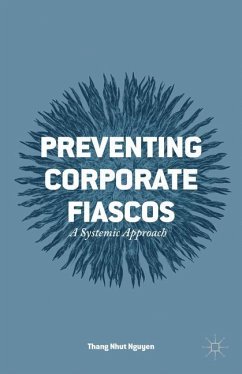Through case studies and analysis of bankruptcy and institutional collapse, Preventing Corporate Fiascos examines project failure as the root cause of these disasters and offers a management exceptions system that diagnoses potential failure from the start.
The lasting effects of corporate fiascos on business and the economy have spurred investigations, panel discussions, and research in an attempt to find out why these events happen and ways to prevent them. Through case studies and analysis of bankruptcy and institutional collapse, Preventing Corporate Fiascos examines the root cause of these disasters and offers a management exceptions system that diagnoses potential failure from the start.
Dr. Nguyen's unique framework is inspired by the biological spectrum, using cancer and disease as a metaphor for prevention and destruction. He uses a proven management repertory grid technique to evaluate aberrant and emotionally-charged decisions which could bring an institution to collapse. By recognizing the institution, its employees, the market and the economy as components of the biological spectrum, we can identify aggravating failure and disease and begin to take effective steps toward prevention.
The lasting effects of corporate fiascos on business and the economy have spurred investigations, panel discussions, and research in an attempt to find out why these events happen and ways to prevent them. Through case studies and analysis of bankruptcy and institutional collapse, Preventing Corporate Fiascos examines the root cause of these disasters and offers a management exceptions system that diagnoses potential failure from the start.
Dr. Nguyen's unique framework is inspired by the biological spectrum, using cancer and disease as a metaphor for prevention and destruction. He uses a proven management repertory grid technique to evaluate aberrant and emotionally-charged decisions which could bring an institution to collapse. By recognizing the institution, its employees, the market and the economy as components of the biological spectrum, we can identify aggravating failure and disease and begin to take effective steps toward prevention.
Review Questions for Corporate Fiascos: An Approach to Prevention
Joseph S. Anderson, Professor of Management, NAU
Q1: 1 paragraph on the type of audience you envision for the book as well as the rationale behind your choice (i.e., Academic, Professional, both, etc.)
I see this book appealing to both the academic and professional audience. It depends upon the approach, to a great extent. Will it be presented more as a 'business best-seller' to reach a more popular audience, or more concept and theoretical-based for the academic community? I don't know whether the target of upper management is realistic - they may be most resistant to the ideas as they seem to be the targets the book aims at. I think there is a rich potential here for academic use in graduate classes, as Professor Nguyen suggests. I could see using chapters of it in my MBA course as an additional resource when we cover crisis management. In fact, the proposal has made me think about presenting additional, internally-caused crises rather than the usual externally-based crises we usually talk about in that class.
The focus on corporate failures adds an applied view that is sometimes missing in our classes, the 'How do things go wrong?...and what can we do to avoid that?' view that may be missing in a lot of more theoretical approaches. It is also appealing that the author has chosen to use a wide variety of businesses, industries (and government, apparently) and functional areas to illustrate the examples. This should appeal to a wide variety of readers, and it makes it more useful to use as modules in a graduate course such as mine.
Q2: 1 paragraph on the quality and significance of the project (i.e., Is the work original? How does it stack up with existing works in the field? etc.)
Organizational fiascos or failures are inherently interesting to people interested in business, projects, and other dimensions of the work environment. The work appears to be novel, innovative and original. The cancer metaphor for things going wrong in organizations is especially appealing. What appeals to me is the fit of the metaphor - like a body, and organization can be 'infected' throughout the entire system, or in related or independent units in the organization. I can see the systemic view of the organism as the culture view of organizations, when the whole system contains malignancies that threaten the existence of the organism/organization. It also ties in nicely to the different levels of decision-making, where if there is infection in the units making decisions (brain or upper management) then those decisions will not be in the interest of organism/organization thriving or ultimately, survival.
Q3: 1-2 paragraphs on the structure, organization, and presentation of the material (include any recommendations for revisions here)
Structure and organization in the proposal appear to be logical and flow well. It's a bit difficult to judge from the brief sections here whether that would actually be the case, but it has the appearance of an attractive package here. What isn't clear is whether the solutions the author suggests have been demonstrated in any of the situations he uses as examples. It is suggested that a software company may use these solutions, and it would be much more persuasive if this is well-demonstrated. For some readers, it may be a bit of a jump to go from a software company to their own industry or functional area, since there is some parochialism when we think of software situations related to our own different areas of endeavor. If readers see software as a totally different environment, they may be less accepting of the application to their own areas of interest.
Joseph S. Anderson, Professor of Management, NAU
Q1: 1 paragraph on the type of audience you envision for the book as well as the rationale behind your choice (i.e., Academic, Professional, both, etc.)
I see this book appealing to both the academic and professional audience. It depends upon the approach, to a great extent. Will it be presented more as a 'business best-seller' to reach a more popular audience, or more concept and theoretical-based for the academic community? I don't know whether the target of upper management is realistic - they may be most resistant to the ideas as they seem to be the targets the book aims at. I think there is a rich potential here for academic use in graduate classes, as Professor Nguyen suggests. I could see using chapters of it in my MBA course as an additional resource when we cover crisis management. In fact, the proposal has made me think about presenting additional, internally-caused crises rather than the usual externally-based crises we usually talk about in that class.
The focus on corporate failures adds an applied view that is sometimes missing in our classes, the 'How do things go wrong?...and what can we do to avoid that?' view that may be missing in a lot of more theoretical approaches. It is also appealing that the author has chosen to use a wide variety of businesses, industries (and government, apparently) and functional areas to illustrate the examples. This should appeal to a wide variety of readers, and it makes it more useful to use as modules in a graduate course such as mine.
Q2: 1 paragraph on the quality and significance of the project (i.e., Is the work original? How does it stack up with existing works in the field? etc.)
Organizational fiascos or failures are inherently interesting to people interested in business, projects, and other dimensions of the work environment. The work appears to be novel, innovative and original. The cancer metaphor for things going wrong in organizations is especially appealing. What appeals to me is the fit of the metaphor - like a body, and organization can be 'infected' throughout the entire system, or in related or independent units in the organization. I can see the systemic view of the organism as the culture view of organizations, when the whole system contains malignancies that threaten the existence of the organism/organization. It also ties in nicely to the different levels of decision-making, where if there is infection in the units making decisions (brain or upper management) then those decisions will not be in the interest of organism/organization thriving or ultimately, survival.
Q3: 1-2 paragraphs on the structure, organization, and presentation of the material (include any recommendations for revisions here)
Structure and organization in the proposal appear to be logical and flow well. It's a bit difficult to judge from the brief sections here whether that would actually be the case, but it has the appearance of an attractive package here. What isn't clear is whether the solutions the author suggests have been demonstrated in any of the situations he uses as examples. It is suggested that a software company may use these solutions, and it would be much more persuasive if this is well-demonstrated. For some readers, it may be a bit of a jump to go from a software company to their own industry or functional area, since there is some parochialism when we think of software situations related to our own different areas of endeavor. If readers see software as a totally different environment, they may be less accepting of the application to their own areas of interest.








